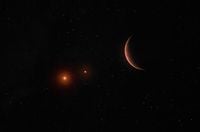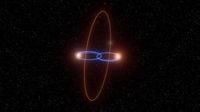Astronomers have discovered a Tatooine-like world orbiting a pair of brown dwarfs in an unusual polar orbit, marking a significant milestone in exoplanet research. The newly identified exoplanet, named 2M1510 (AB) b, orbits its two host stars at a 90-degree angle, a configuration never before confirmed in such a system.
On April 16, 2025, researchers announced their findings in a publication in Science Advances, revealing that the planet's orbit is perpendicular to the orbits of the two brown dwarfs, which are larger than typical planets but smaller than stars. This discovery was made using the Ultraviolet and Visual Echelle Spectrograph (UVES) on the European Southern Observatory's Very Large Telescope (VLT) located at the Paranal Observatory in Chile.
The brown dwarfs, known as 2M1510, are part of an eclipsing binary system, meaning they orbit each other and periodically obscure one another from view, a phenomenon that adds to the complexity of observing their dynamics. This is only the second known pair of eclipsing brown dwarfs, making this discovery particularly noteworthy.
Thomas Baycroft, a Ph.D. student at the University of Birmingham and the lead author of the study, expressed his excitement about the findings: "I am particularly excited to be involved in detecting credible evidence that this configuration exists." His colleague, Amaury Triaud, also from the University of Birmingham, noted, "A planet orbiting not just a binary, but a binary brown dwarf, as well as being on a polar orbit is rather incredible and exciting."
Interestingly, the existence of planets orbiting in perpendicular orbits around binary stars has been theorized but never confirmed until now. Astronomers had previously seen hints of such configurations, yet lacked definitive evidence. Baycroft explained, "We had hints that planets on perpendicular orbits around binary stars could exist, but until now we lacked clear evidence of this type of polar planet."
The research team made the serendipitous discovery while refining the orbital and physical parameters of the brown dwarfs. They observed unusual gravitational influences affecting the motion of the stars, which led them to conclude that a planet was exerting gravitational forces on the brown dwarfs, necessitating a polar orbit to explain the observed dynamics. Triaud remarked, "The discovery was serendipitous, in the sense that our observations were not collected to seek such a planet or orbital configuration. As such, it is a big surprise and shows what is possible in the fascinating universe we inhabit."
The two brown dwarfs were initially detected in 2018 as part of the Search for habitable Planets EClipsing ULtra-cOOl Stars (SPECULOOS) project, which aims to identify potentially habitable worlds around cool stars. The pioneering analysis that led to this discovery was developed by Dr. Lalitha Sairam, who improved measurement precision significantly, allowing the team to discern the delicate gravitational interactions at play.
Baycroft's team’s findings not only highlight the uniqueness of the 2M1510 (AB) b system but also open new avenues for understanding the dynamics of exoplanetary systems. The peculiar orbital mechanics of this planet provide a rich field for future research, as astronomers seek to determine the physical characteristics of the exoplanet itself.
While the planet 2M1510 (AB) b is reminiscent of the fictional Tatooine from the "Star Wars" universe, it orbits two dim brown dwarfs, which would provide a very different kind of light than the twin suns of Tatooine. Instead of basking in bright sunlight, this planet would experience a more subdued illumination, akin to a double dose of moonlight.
The discovery of 2M1510 (AB) b represents a significant leap in our understanding of planetary systems, particularly those involving brown dwarfs. As astronomers continue to refine their observational techniques and explore the cosmos, such discoveries challenge our understanding of what is possible in the universe, suggesting that planetary configurations can be far more diverse than previously imagined.
In conclusion, the confirmation of a polar orbiting exoplanet around a pair of brown dwarfs not only enriches the catalog of known exoplanets but also sparks curiosity about the myriad configurations that exist beyond our solar system. As research continues, the implications of such findings will undoubtedly lead to deeper insights into the formation and evolution of planetary systems.







